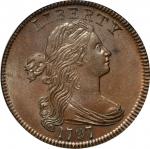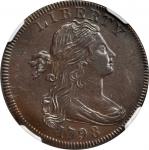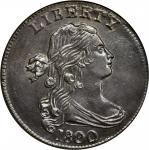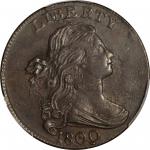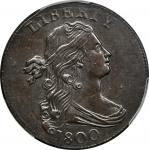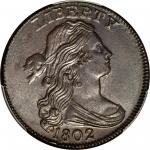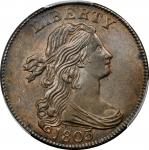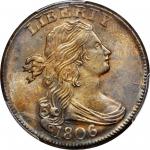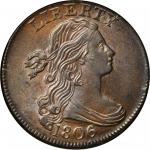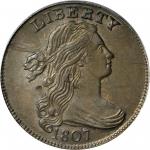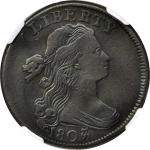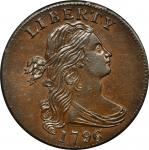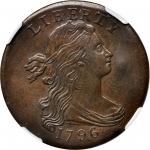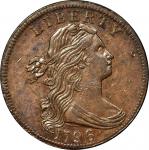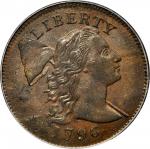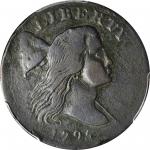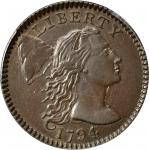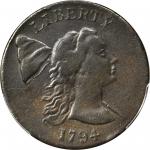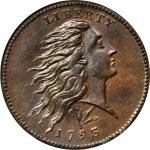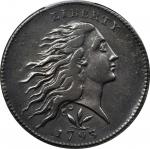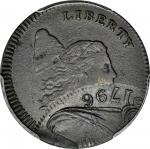1796 Draped Bust Cent--Struck 65% Off Center, Cut Down and Overstruck by 1797 C-3b Half Cent Dies--NC-7. Rarity-8. EF Details--Environmental Damage (PCGS).This famous rarity has been the object of considerable debate among early copper enthusiasts regarding the order of striking, i.e. whether the initial impression came from the half cent or cent dies. PCGS has certified this coin as a 1797 C-3b half cent (coin #35113), the insert stating: "O/S by 1796 NC-7." Since its discovery in 1994, however, the general consensus has been that this coin started as a 1796 Draped Bust cent that as struck 65% off center, the planchet subsequently cut down and overstruck by 1797 C-3b half cent dies. Indeed, this is how John Whitney Walter collected this coin, and it is how it is listed in the census of known examples in <em>Walter Breens Encyclopedia of Early United States Cents: 1793-1814</em> (2000) and on the <em>PCGS CoinFacts</em> website. This coin has also been cataloged as a 1796 NC-7 Draped Bust cent in our (Bowers and Merenas) Herman Halpern Collection sale of March 1995, and in our (Stacks) subsequent offering of the John Whitney Walter Collection of Coins of 1796 (May 1999). We reprint here (with minor edits and updates) our cataloging from the May 1999 Walter Collection offering here, along with a significant accompanying article by John Landis that makes a strong case for the manner in which this intriguing coin was produced. A dramatically off centered overstrike by a 1797 Lettered Edge half cent (Breen-3a, Cohen-3b) using the 1796 NC-7 Cent as planchet stock. One of just three known NC-7s, one of which is impounded in the ANS Collection. The ANS coin, tooled on the obverse, condemned by Sheldon, rehabilitated by Breen, has been graded EAC Good-6. This coin is dark olive and brown in color. The surfaces are microgranular. The half cent overstrike was well centered and struck. The 1796 large cent undertype was originally struck off center on both sides by approximately 65% and this was probably why the cent was used as the planchet for the half cent. On the obverse of the half cent can be seen the base of the obverse of the NC-7 large cent, showing the cents full 1796 date, the lowest hair curl, Libertys bodice and her bosom. On the reverse of the half cent is the upper right portion of the large cent undertype, showing the topmost leaves of the wreath and [STA]TES OF from the cents legend. The close placement of the 6 in the cents date, the double leaf at top of right branch of the wreath on the reverse, and the fact that the lowest of the double leaves is the longer of the two, all rule out any previously known 1796 large cent obverse for the front die (save 26) and point clearly to Reverse 143 of 1797 as the back die. The NC-7 variety was listed and described by George H. Clapp and Howard R. Newcomb in their monograph <em>The United States Cents of the Years 1795, 1796, 1797, and 1800</em> published by the American Numismatic Society in 1947. Clapp and Newcomb gave it their number 34 (20-BB) and described it as "Obv. New, Rev. S.1797." They based their description and listing on the then single known example, which was owned by Clapp. Dr. Sheldon included the new variety in his <em>Early American Coppers</em> (1949) but delisted it in <em>Penny Whimsy</em> (1958) because the then unique Clapp specimen had been tooled on the obverse and Sheldon did not believe the obverse die was a new discovery. Sheldon wrote in 1958 that he had only included it in his 1949 listing out of deference to Clapp. There things stayed, at least publicly, with NC-7 removed, until late 1994/early 1995, when the presently offered coin was consigned unattributed to Bowers and Merena as a 1796 half cent error. (We note that the late Walter Breen had already decided that the CN-34 in the ANS was a new combination and that Sheldons condemnation of it had been incorrect.) The Bowers and Merena cataloger correctly attributed the large cent reverse die as S-143 of 1797 and the obverse as the die of Clapp-Newcomb 34, Sheldons old 26-BB. To confirm the attribution, the coin was brought to the ANS and compared side by side to the discovery coin CN-34 that was there from the Clapp Collection. The comparison proved the accuracy of the attribution, as well as the authenticity of the Clapp coin, even though its obverse was tooled. Since then, only one other 1796 NC-7 cent has been confirmed, bringing the census of known examples to three:<p>1- <strong>PCGS EF Details--Environmental Damage.</strong> Ex our (Bowers and Merenas) Herman Halpern Collection sale, March 1995, lot 2307; our (Stacks) sale of the John Whitney Walter Collection of the Coins of 1796, May 1999, lot 1758. <em><strong>The present example</strong></em>, unattributed when consigned to Bowers and Merena in October 1994, the attribution determined by March Borckardt and confirmed by Denis Loring and Dr. John Kleeberg.<p>2 - <strong>EAC Good-6.</strong> John P. Kennedy; George H. Clapp, March 1928, discovered in the Kennedy Collection and described by Clapp in <em>The Numismatist</em>, Vol. XLI, 1928, p. 315; B. Max Mehl, privately; "Colonel" E.H.R. Green; Burdette G. Johnson (St. Louis Stamp & Coin Co.), April 1946; George H. Clapp; ANS Collection.<p>3 - <strong>EAC AG-3.</strong> Purchased attributed by Rod Burress, 1999; Daniel W. Holmes. Jr., 1999.In summary, this is one of just two collectable examples of this Rarity-8 1796 NC-7, a coin that combines both great rarity and importance for numismatic history. There is some disagreement in the copper community over how this coin was actually struck. Many believe that the 1796 NC-7 cent came first and that the 1797 half cent is struck over the cent, as described here. Others believe that the large cent is struck over the half cent. Simply looking at the coin, even under high magnification, does not completely answer the question of which came first, the half cent or the cent. For example, Breen noted that it was not possible to figure out whether the 1796 S-115 cent or the 1797 half cent came first on the piece Frank Stewart found when his men demolished the first mint building site (published 1916 in <em>The Numismatist</em>). Luckily for numismatics, Ron Landis of the Gallery Mint Museum consented to try an experiment. With the present coin before him as a guide, and using dies of his own making, Ron struck sample coins both ways. First, he struck 1796 large cent dies off center onto a planchet, then cut the off center struck large cent down to half cent planchet size. He then lettered the edge with a half cent legend, and then used the off center strike as a planchet for his 1797 half cent dies. Next, he struck a centered, edge lettered 1797 half cent and then using that coin as a planchet struck it off center with the 1796 large cent dies he had made. Finally, Ron placed one each of his sample coins alongside this NC-7 and compared them. There was no question any more as to which came first. The large cent was seen to have been struck first, off center, and this "spoiled cent (as Breen called them) was used as a planchet for the 1797 half cent. Mr.. Walter emailed EAC Region 8 in February with the news about Rons experiments and we reproduce excerpts from his communication here. He wrote: "<em>Having worked in a metalworking shop on and off most of my life, and still having a pretty fair metal shop of my own (minus the lathe which I had to give up for lack of room), which includes among other good stuff, a 20 ton metal punch for punching out chassis and control panels, I always felt that it would not be possible to produce this coin with as much of the Half Cents detail remaining, if the Half Cent didnt come last. My thanks to all of you out there who have waxed eloquently on this subject for the past four years. In this case, it was back to basics that won the battle. The die sequencers still have their day in court, but not on this issue. Its easy to see why the NC-7 variety is so rare. Its the trauma that the off striking of the Large Cent puts on the Large Cent dies when it was off struck so badly; the die pair probably broke soon, or right after that off strike. When I talked to Ron about this fact, he said that the steel available to him is far better than the steel that was available to the early Mint for making dies. Also, my past research through the early Mints records suggests that the Mint wasnt too expert at annealing its dies. This explains why there were so many dies used to strike early coinage, 92 dies (46 obverse & 46 reverse) were used to strike the small amount of 1796 dated coins; they just kept breaking. Ron said he was very careful in making the overstrike so that he would not break his Large Cent dies. Ron feels that the Mint used an automatic coin feeder to make coins and is still trying to replicate one that could have been used back in 1796." </em>Ron Landis description of how he made his "NC-7" copies, along with photographs of each coinage produce as it progressed from large cent to half cent, follows. Also an example of a half cent overstruck with the large cent dies, for comparison. Recreating the 1797 Half Cent Over NC-7 Spoiled Cent By Ron Landis A few years back, I had the pleasure of viewing the most important collection of 1796 coins ever assembled. This collection goes beyond just every denomination, which is difficult enough to begin with, but is composed of Finest or Among the Finest examples of every known die marriage save one of that date. I had just begun reproducing a 14 piece set of 1796 coins, and having completed the first piece of the set, the Quarter Dollar, was showing it for the first time at the Denver ANA convention. Our bourse table was set up just a few steps away from John Whitney Walters exhibit, so I found myself hunched over the collection many times a day, trying to keep drool off the cases. In a short time, I had the honor of meeting John [Whitney Walter], who generously brought his collection to display at the convention. I was impressed by his genuine love of numismatics and his willingness to share information about his collection. John stood close by his exhibition several times throughout each day, to answer questions about the coins it contained. The subject of conversation found its way to a most intriguing coin in his collection, which was actually a 1797 Half Cent. It was in his 1796 Collection because it also showed an off center impression of a 1796 Draped Bust Cent of the extremely rare NC-7 variety. John pointed out to me that this coin had been under debate for quite some time as to what came first, the Cent or the Half Cent. My first impression looking at it through the showcase was that the Cent was struck off center over the Half Cent. Intrigued by this puzzle, I offered to try to reproduce this coin both ways when I had both sets of die types in place. Since first viewing the coin, I found a large photograph of it on the cover of <em>Error Scope</em>, and hung it on my bulletin board to look at occasionally. After a while, I really felt as though I could reproduce the same characteristics both ways, and would just produce a few sets that could be passed around among numismatists for comparison analysis. When John consigned his 1796 set to Stacks, he asked the firm to send me the 1796 NC-7 for study. I was convinced the coin had the answer to how it was made and which came first, and I was especially interested in what clues the edge might hold. Within a few minutes of examining the coin, I found one very convincing clue that I had previously overlooked from the two dimensional photograph I was used to seeing. Around the perimeter of this coin in the field of the Cent impression is a definite raised portion which is the upsetting caused created when the lettered edge was applied. If the Cent strike had come second, this area should be completely flat to the edge of the coin, because common practice then was to edge letter the planchet before striking. Therefore, the Cent impression must have been struck before the planchet was cut out and the edge lettered. I might add that the upsetting on this coin is not so subtle that it cannot be seen with the naked eye, once you know what youre looking at. This was not uncommon in 1797. Many of the Half Cents of that year were struck from spoiled Cent stock or from cut down Talbot, Allum & Lee tokens. With Half Cents being struck from a large amount of salvaged off center Cents, it is also a good indication that a mechanical feed system was in place at this time, but that is another research topic. Under a microscope, I also noticed a few other clues that further convinced me the Half Cent planchet was cut from a spoiled Cent. On the reverse, the leaves in the wreath of the Cent curl slightly around the edge of the coin, indicating this was the side that went through the hole of the cutting die, leaving the sharp edge of the planchet on the obverse. In my opinion, this is why the upsetting is more prominent on the obverse. I also made one other observation that is not so convincing, but should be pointed out. The edge lettering on the thick portion of the planchet runs straight and true, but then suddenly runs off the edge through the Cent portion and opposing area, showing the planchet was thinner in this area and ran into the area of least resistance, namely, the two opposing corners of the edge dies, forming a beveled edge in this area, cutting off half the lettering. We see this effect at the Gallery Mint Museum whenever we run a planchet that is too thin for a given set of edge dies. This in itself is not uncommon on 1796 Half Cents. Walter Breen speculates this was caused by warped dies and partially due to too thin a planchet. I question the warped die theory, since all edge dies must be a rather substantial piece of steel and the Half Cent edge dies are somewhat short as edge dies go. My experience leads me to believe that what little warping might occur in the hardening of such a piece of steel would not cause such a radical effect on a planchet. We went ahead and tried to reproduce the NC-7 using two different methods (see the examples illustrated here). Although there are many other variables that come into play, basically, we were able to reproduce the same clarity of both impressions using both methods, a feature on the original that makes this coins striking sequence so difficult to figure out. We were also able to keep most of the coins we struck very round, another confusing feature of the original. Not all of them displayed this sort of balance, however. In both methods, we came up with examples that displayed characteristics of each strike sequence. Of the 31 Cent over Half Cent pieces we produced every one showed flat fields all the way off the edge, sometimes showing remnants of the Half Cent date flattened out, sometimes bulging out in that area, but never showing a ghost of the Half cents bust over the Cents bust. Only two pieces made this way showed very slight remnants of the Half Cents dentils, a characteristic visible on the original coin. We made 24 other examples using a method of cutting the planchet from a pre-manufactured "spoiled Cent" and we found results that resembled the appearance of the original coin. In all cases, the upsetting was clearly visible as on the original. Our rimming was a little heavier, so the final strike shows more dentils than can be seen on the original, but nevertheless the copies made this way show dentils consistently. Also, on many of the pieces created this way the slight impression of the Half Cent bust is visible on the high points of the Cent bust, a diagnostic on the original not visible on any of the copies made using the other sequence (i.e., Cent over Half Cent).It has been suggested that the off center strike that first occurred may have been the reason why the NC-7 die did not last long. Although this is certainly not a good thing for dies to go through, it is something that all dies endure at one time or another when a mechanical planchet feeder is in use. A good solid die, properly hardened and tempered, should be able to take this kind of abuse. If the die did break on this strike, it is more likely due to a hidden fracture in that particular bit of steel. Our dies managed to survive all right even though we hit them full strength over 100 consecutive times. I enjoyed the challenge and thrill of being able to spend some time with this coin and to try to figure out this technical puzzle. This is how I get my kicks and is what makes error coins so interesting.From the John Whitney Walter Collection. Earlier from our (Bowers and Merenas) Herman Halpern Collection sale, March 1995, lot 2307; our (Stacks) sale of the John Whitney Walter Collection of the Coins of 1796, May 1999, lot 1758. This coin was unattributed when consigned to Bowers and Merena in October 1994, the attribution determined by March Borckardt and confirmed by Denis Loring and Dr. John Kleeberg.

